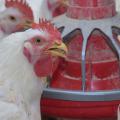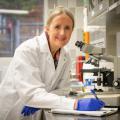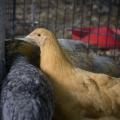Constructing a Polystyrene Incubator
 The following paragraphs and illustrations are designed to guide the reader through the construction of a small, inexpensive incubator made from a polystyrene ice chest. A minimum number of hand tools are required and include a sharp knife, screwdriver, metal shears, and a pair of pliers. Gather all equipment and supplies listed below together before starting construction. The construction should take no longer than about two hours.
The following paragraphs and illustrations are designed to guide the reader through the construction of a small, inexpensive incubator made from a polystyrene ice chest. A minimum number of hand tools are required and include a sharp knife, screwdriver, metal shears, and a pair of pliers. Gather all equipment and supplies listed below together before starting construction. The construction should take no longer than about two hours.
List of Materials
- Polystyrene ice chest (12-16" x 20-24" x 12"-15")
- Heating cable
- Micro-switch assembly (thermostat)
- Glass (approx. 10"x14")
- ¼" welded wire - hardware cloth (24"x36")
- Cake tin (9"x14"x1½")
- Thermometer
- Masking tape
 Begin construction on the platform for the eggs. Cut the welded wire or hardware cloth so it is six inches wider than the inside bottom of the ice chest. Cut a three-inch square from each corner and bend the projecting pieces at right angles to form legs for the platform. Remove any rough edges and cover the cut edges with tape. Install the cake pan and the platform in the bottom of the chest. (Step 1)
Begin construction on the platform for the eggs. Cut the welded wire or hardware cloth so it is six inches wider than the inside bottom of the ice chest. Cut a three-inch square from each corner and bend the projecting pieces at right angles to form legs for the platform. Remove any rough edges and cover the cut edges with tape. Install the cake pan and the platform in the bottom of the chest. (Step 1)
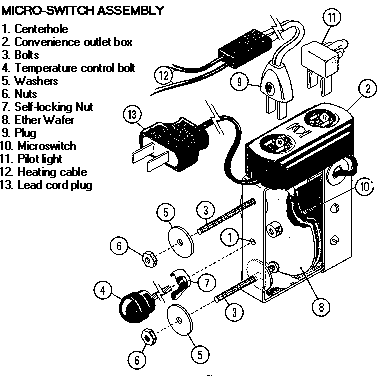 Then install the heating element and micro-switch assembly. Protect the polystyrene sides from the heating element by placing masking tape or similar material around the interior of the chest. Place one strip of tape 2½-inches from the top. One strip is located one inch above the platform, and another strip is placed midway between the top and bottom strips.
Then install the heating element and micro-switch assembly. Protect the polystyrene sides from the heating element by placing masking tape or similar material around the interior of the chest. Place one strip of tape 2½-inches from the top. One strip is located one inch above the platform, and another strip is placed midway between the top and bottom strips.
Position the micro-switch assembly on one of the end walls so the center hole is about five inches below the top of the chest. With a pencil or other sharp pointed tool, make three holes in the chest for the temperature control bolt and two mounting bolts. Mount the switch by inserting the mounting bolt, add the washers, and tighten the nuts until the unit is firmly attached (Step 2). Insert the heating cable plug and the pilot light into the switch assembly before plugging in the lead cord. Check the unit to see if the pilot light glows and the heating cable warms up when the switch is activated. Both should be off when the switch is turned off. After checking the unit, remove the lead cord from the electrical outlet.
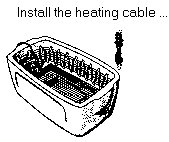 Fasten the midpoint of the cable to the top strip of tape at the opposite end of the chest. Using tape, fasten the remainder of the cable to the top and bottom strips of tape alternately while forming serpentine loops (Step 3). The cable does not need to be fastened to the middle strip of tape. The heating element can also be attached to the sides of the ice chest using loops of heat-resistant strapping that raises the cable away from the polystyrene surface. The attachment loops can be fastened using small bolts with washers that extend through the ice chest. Do not allow the cable loops to touch each other.
Fasten the midpoint of the cable to the top strip of tape at the opposite end of the chest. Using tape, fasten the remainder of the cable to the top and bottom strips of tape alternately while forming serpentine loops (Step 3). The cable does not need to be fastened to the middle strip of tape. The heating element can also be attached to the sides of the ice chest using loops of heat-resistant strapping that raises the cable away from the polystyrene surface. The attachment loops can be fastened using small bolts with washers that extend through the ice chest. Do not allow the cable loops to touch each other.
A window may be installed in the lid of the chest so you can see the eggs and chicks as they hatch. Center the piece of glass on the top of the lid and trace its outline with a marker. Remove the glass and draw a smaller rectangle inside the first with all sides parallel and 3/4 inch inside the traced glass rectangle. With a sharp knife, cleanly cut out the smaller rectangle and discard it. Then carefully cut around the outline of the glass on top of the lid to a depth of only one-fourth inch. Do not cut through the top.
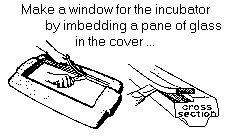 On the cut edge made when the rectangle was removed, mark a line ¼-inch from the top of the lid. With a sharp knife or razor, cut along the line until it meets with the cut made earlier. The strip should lift out easily to form a recessed ridge around the rectangular hole (Step 4). Place the glass in the recessed area and secure it with tape.
On the cut edge made when the rectangle was removed, mark a line ¼-inch from the top of the lid. With a sharp knife or razor, cut along the line until it meets with the cut made earlier. The strip should lift out easily to form a recessed ridge around the rectangular hole (Step 4). Place the glass in the recessed area and secure it with tape.
Proper ventilation is provided by sixteen ¼-inch holes in the sides of the chest. Make the holes with a pencil or other sharp instrument. On each of the large sides of the chest, make a row of four holes two-inches from the bottom, and another row of four holes located three-inches from the top. The holes in each row should be four-inches apart.
Test the incubator by placing a shallow layer of warm water (100oF.) in the pan. Place the thermometer on the wire platform, put the lid on the chest, and plug in the lead cord. Turn the temperature control bolt until the pilot light goes on. Frequently readjust the control bolt until the desired temperature is reached. The pilot light and heating cable should shut off. Allow the unit to operate several hours before placing the eggs in it. This allows time to see how well the unit maintains a constant temperature.
Publications
News
STARKVILLE, Miss. -- Until an avian flu vaccine for chickens or other alternative is federally approved, commercial poultry operations in the U.S.
STARKVILLE, Miss. -- If egg prices have seemed higher than ever lately, it’s because they are, and consumers can place much of the blame squarely at the feet of the ongoing bird flu outbreak.
With highly pathogenic avian influenza, or HPAI, in the environment in Mississippi, owners of backyard flocks have to take extra steps to keep their chickens healthy.
Avian influenza poses an extremely low risk to human health and none to food safety in Mississippi, but its presence poses a risk to backyard flocks and the state’s $3 billion commercial poultry industry.


